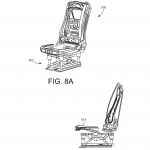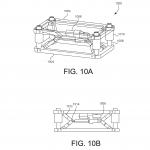

News
Tesla patent reveals Semi truck seat suspension in the works for added safety
Tesla has submitted a patent that would improve its Semi-truck’s centered seat design by utilizing a suspension system on the architecture of the driver’s seat to add additional safety to the operator of the vehicle.
The patent notes that scissor-lift designs are commonly used in large vehicle seats, like in a semi-truck. This design includes pivoting legs that cross each other, allowing seats to be adjustable. However, this architecture has some drawbacks, especially when an accident occurs. In the event of a collision, the “all belts to seat” (ABTS) development “requires the frame of the seat to withstand the expected loads of the occupant and distribute them to the vehicle body. However, the scissor-leg designs were not originally intended for ABTS solutions and are not efficient at distributing the loads,” the patent states. The intention is to make the seat safer and more comfortable, an idea that could save drivers of the Semi in the long run.
“For a driver, adjusting the height of the seat can be important in ensuring a safe driving position. For a passenger, height adjustment can provide increased comfort. Truck seats with scissor-lift designs can be raised or lowered using an airbag positioned underneath the seat, with the scissor legs being more, or less, extended based on the state of inflation.”
- Tesla’s proposed suspension seat design. (Credit: U.S. Patent Office)
- Tesla’s suspension seat at lowest setting. (Credit: U.S. Patent Office)
- Tesla’s suspension seat at highest setting. (Credit: U.S. Patent Office)
- Tesla’s seat suspension system. (Credit: U.S. Patent Office)
Tesla’s proposed suspension seat design. (Credit: U.S. Patent Office)
Safety and comfort are of the utmost importance to truck drivers, as many of them are traveling across the country in the Semi they are operating. Many drivers work at a rate of pay that depends on the number of miles they travel in a given shift. This can attribute to long periods of time behind the wheel, making it important for the driver to feel comfortable and safe at all times. According to the Federal Highway Administration, truck drivers can travel between 45,000 and 100,000 miles a year. This makes it pertinent for truck-makers to design vehicles that are comfortable enough to allow extended driving sessions.
The design Tesla is proposing would increase safety in the event of a crash, while also benefiting drivers of different heights. When adjusting the height of the seat, the driver is inflating or deflating an airbag to either raise or lower their positioning. Depending on the inflation of this airbag, the spring force can change, and this can cause differing results in the event of an accident.
“Many seats feature suspension for the comfort of the occupant. In truck seats with a scissor-lift design, the airbag also serves as a spring to provide suspension, and a damper can be added to absorb shock. However, because the airbag is also used to control the seat height, ride characteristics are affected by the height adjustment,” Tesla states in the patent’s background.
Tesla plans to include this suspension system by having a “multi-post architecture” that would couple sleeves to sets of lift links. They also plan to modify the height adjustment system that would coincide with the seat’s suspension.
“The height adjustment system comprises a four-bar linkage. The height adjustment system is positioned on top of the suspension system. The vehicle seat further includes a plate riding on the suspension system, the sleeves are coupled to the plate, and respective first ends of the pairs of lift links are pivotally coupled to the plate. The multi-post architecture includes posts coupled to a plate configured for fore/aft adjustment on a track,” Tesla wrote.
Overall, Tesla seems to be designing its Semi to be the safest tractor-trailer on the road, hands down. Safety is a priority for the company to begin with, but the development of new methods to create a safer driving experience stands strong and firm with concepts outlined in by the company in these recent patent applications.
The Semi has been ordered by multiple companies that are looking for a more environmentally-friendly logistics option. It will begin a limited production sometime in 2020.
The full text of Tesla’s suspension seat design could be accessed here.

Elon Musk
Starlink passes 9 million active customers just weeks after hitting 8 million
The milestone highlights the accelerating growth of Starlink, which has now been adding over 20,000 new users per day.

SpaceX’s Starlink satellite internet service has continued its rapid global expansion, surpassing 9 million active customers just weeks after crossing the 8 million mark.
The milestone highlights the accelerating growth of Starlink, which has now been adding over 20,000 new users per day.
9 million customers
In a post on X, SpaceX stated that Starlink now serves over 9 million active users across 155 countries, territories, and markets. The company reached 8 million customers in early November, meaning it added roughly 1 million subscribers in under seven weeks, or about 21,275 new users on average per day.
“Starlink is connecting more than 9M active customers with high-speed internet across 155 countries, territories, and many other markets,” Starlink wrote in a post on its official X account. SpaceX President Gwynne Shotwell also celebrated the milestone on X. “A huge thank you to all of our customers and congrats to the Starlink team for such an incredible product,” she wrote.
That growth rate reflects both rising demand for broadband in underserved regions and Starlink’s expanding satellite constellation, which now includes more than 9,000 low-Earth-orbit satellites designed to deliver high-speed, low-latency internet worldwide.
Starlink’s momentum
Starlink’s momentum has been building up. SpaceX reported 4.6 million Starlink customers in December 2024, followed by 7 million by August 2025, and 8 million customers in November. Independent data also suggests Starlink usage is rising sharply, with Cloudflare reporting that global web traffic from Starlink users more than doubled in 2025, as noted in an Insider report.
Starlink’s momentum is increasingly tied to SpaceX’s broader financial outlook. Elon Musk has said the satellite network is “by far” the company’s largest revenue driver, and reports suggest SpaceX may be positioning itself for an initial public offering as soon as next year, with valuations estimated as high as $1.5 trillion. Musk has also suggested in the past that Starlink could have its own IPO in the future.
News
NVIDIA Director of Robotics: Tesla FSD v14 is the first AI to pass the “Physical Turing Test”
After testing FSD v14, Fan stated that his experience with FSD felt magical at first, but it soon started to feel like a routine.

NVIDIA Director of Robotics Jim Fan has praised Tesla’s Full Self-Driving (Supervised) v14 as the first AI to pass what he described as a “Physical Turing Test.”
After testing FSD v14, Fan stated that his experience with FSD felt magical at first, but it soon started to feel like a routine. And just like smartphones today, removing it now would “actively hurt.”
Jim Fan’s hands-on FSD v14 impressions
Fan, a leading researcher in embodied AI who is currently solving Physical AI at NVIDIA and spearheading the company’s Project GR00T initiative, noted that he actually was late to the Tesla game. He was, however, one of the first to try out FSD v14.
“I was very late to own a Tesla but among the earliest to try out FSD v14. It’s perhaps the first time I experience an AI that passes the Physical Turing Test: after a long day at work, you press a button, lay back, and couldn’t tell if a neural net or a human drove you home,” Fan wrote in a post on X.
Fan added: “Despite knowing exactly how robot learning works, I still find it magical watching the steering wheel turn by itself. First it feels surreal, next it becomes routine. Then, like the smartphone, taking it away actively hurts. This is how humanity gets rewired and glued to god-like technologies.”
The Physical Turing Test
The original Turing Test was conceived by Alan Turing in 1950, and it was aimed at determining if a machine could exhibit behavior that is equivalent to or indistinguishable from a human. By focusing on text-based conversations, the original Turing Test set a high bar for natural language processing and machine learning.
This test has been passed by today’s large language models. However, the capability to converse in a humanlike manner is a completely different challenge from performing real-world problem-solving or physical interactions. Thus, Fan introduced the Physical Turing Test, which challenges AI systems to demonstrate intelligence through physical actions.
Based on Fan’s comments, Tesla has demonstrated these intelligent physical actions with FSD v14. Elon Musk agreed with the NVIDIA executive, stating in a post on X that with FSD v14, “you can sense the sentience maturing.” Musk also praised Tesla AI, calling it the best “real-world AI” today.
News
Tesla AI team burns the Christmas midnight oil by releasing FSD v14.2.2.1
The update was released just a day after FSD v14.2.2 started rolling out to customers.

Tesla is burning the midnight oil this Christmas, with the Tesla AI team quietly rolling out Full Self-Driving (Supervised) v14.2.2.1 just a day after FSD v14.2.2 started rolling out to customers.
Tesla owner shares insights on FSD v14.2.2.1
Longtime Tesla owner and FSD tester @BLKMDL3 shared some insights following several drives with FSD v14.2.2.1 in rainy Los Angeles conditions with standing water and faded lane lines. He reported zero steering hesitation or stutter, confident lane changes, and maneuvers executed with precision that evoked the performance of Tesla’s driverless Robotaxis in Austin.
Parking performance impressed, with most spots nailed perfectly, including tight, sharp turns, in single attempts without shaky steering. One minor offset happened only due to another vehicle that was parked over the line, which FSD accommodated by a few extra inches. In rain that typically erases road markings, FSD visualized lanes and turn lines better than humans, positioning itself flawlessly when entering new streets as well.
“Took it up a dark, wet, and twisty canyon road up and down the hill tonight and it went very well as to be expected. Stayed centered in the lane, kept speed well and gives a confidence inspiring steering feel where it handles these curvy roads better than the majority of human drivers,” the Tesla owner wrote in a post on X.
Tesla’s FSD v14.2.2 update
Just a day before FSD v14.2.2.1’s release, Tesla rolled out FSD v14.2.2, which was focused on smoother real-world performance, better obstacle awareness, and precise end-of-trip routing. According to the update’s release notes, FSD v14.2.2 upgrades the vision encoder neural network with higher resolution features, enhancing detection of emergency vehicles, road obstacles, and human gestures.
New Arrival Options also allowed users to select preferred drop-off styles, such as Parking Lot, Street, Driveway, Parking Garage, or Curbside, with the navigation pin automatically adjusting to the ideal spot. Other refinements include pulling over for emergency vehicles, real-time vision-based detours for blocked roads, improved gate and debris handling, and Speed Profiles for customized driving styles.












